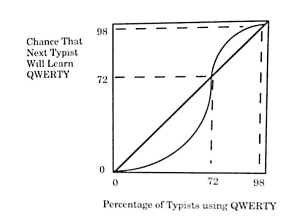
 This item touches on Economics which is a little outside the normal focus for this blog but we thought the analytical curiosity would interest scientists and economists alike. Young women are underrepresented (at A-level) in Economics as well as Maths and Physics.
This item touches on Economics which is a little outside the normal focus for this blog but we thought the analytical curiosity would interest scientists and economists alike. Young women are underrepresented (at A-level) in Economics as well as Maths and Physics.
As Apple roll out their newest collection of iPads, MacBooks, and iPhones, onto the shelves in the coming weeks, it seems like an apt time to discuss the economics behind the humble QWERTY keyboard.
One would think that such a ubiquitous piece of technology should maximise efficiency-perhaps by reducing the distance between the most frequently used keys, thus increasing the speed of typing, and leaving more time to pursue other tasks. Alas, it is not so!
Indeed, the crux of the problem lies in QWERTY’s very existence. Developed by Christopher Scholes in the 1800s, QWERTY was introduced to increase the distance between the most frequently used keys on typewriters, in order to reduce jamming; it did in fact increase efficiency at the time. However, the Dvorak keyboard is by far the most efficient for today’s modern society, (where we don’t have to contend with nuisance typewriters), reducing the distance travelled by our nimble fingers by up to 50%, and so resulting in a 5-10% decrease in the time spent typing. With statistics such as these we can’t help but wonder why the QWERTY keyboard hasn’t been ousted from the market.  We turn to Game Theory to look at the problem. Take the following graph, comparing the percentage of typists using QWERTY with the probability that the next typist will use QWERTY. When more than 72% of the population use QWERTY, QWERTY is superior, and so the probability that the next typist will learn QWERTY increases. This becomes self-perpetuating, because as more people turn to QWERTY there is a greater incentive for others to adopt the layout also. To understand this, imagine that you are a new typist. You have to decide which keyboard layout to learn to type with. We assume that there are increasing returns associated with the adoption of keyboard layouts, due to economies of scale. Due to a larger percentage of the population using QWERTY, there is a greater demand for QWERTY layout keyboards and other such compatible products, (e.g. laptops), which in turn increases the supply of such products, increasing variety and also decreasing price. Also, with a larger percentage of the population using QWERTY, it seems rational to choose to learn it because your human capital is more easily transferable as you change jobs, as most businesses, (and schools), use QWERTY. You will not have to undergo retraining in order to learn a new layout. This is further reinforced by the fact that as people expect QWERTY to remain dominant, they choose QWERTY. This outweighs the potential benefit of increased efficiency in using the Dvorak layout. Therefore, your payoffs will be higher if you choose the QWERTY layout and you, rationally, reason to do so. This in turn means that you increase, (extremely slightly), the percentage of the population choosing QWERTY, creating an even greater incentive for others to also learn to type with QWERTY. It’s a bandwagon effect. The choice becomes self-reinforcing. As a result, we reach an equilibrium where just under 100% of society uses the QWERTY layout.
We turn to Game Theory to look at the problem. Take the following graph, comparing the percentage of typists using QWERTY with the probability that the next typist will use QWERTY. When more than 72% of the population use QWERTY, QWERTY is superior, and so the probability that the next typist will learn QWERTY increases. This becomes self-perpetuating, because as more people turn to QWERTY there is a greater incentive for others to adopt the layout also. To understand this, imagine that you are a new typist. You have to decide which keyboard layout to learn to type with. We assume that there are increasing returns associated with the adoption of keyboard layouts, due to economies of scale. Due to a larger percentage of the population using QWERTY, there is a greater demand for QWERTY layout keyboards and other such compatible products, (e.g. laptops), which in turn increases the supply of such products, increasing variety and also decreasing price. Also, with a larger percentage of the population using QWERTY, it seems rational to choose to learn it because your human capital is more easily transferable as you change jobs, as most businesses, (and schools), use QWERTY. You will not have to undergo retraining in order to learn a new layout. This is further reinforced by the fact that as people expect QWERTY to remain dominant, they choose QWERTY. This outweighs the potential benefit of increased efficiency in using the Dvorak layout. Therefore, your payoffs will be higher if you choose the QWERTY layout and you, rationally, reason to do so. This in turn means that you increase, (extremely slightly), the percentage of the population choosing QWERTY, creating an even greater incentive for others to also learn to type with QWERTY. It’s a bandwagon effect. The choice becomes self-reinforcing. As a result, we reach an equilibrium where just under 100% of society uses the QWERTY layout.
However, this is an inferior equilibrium. Whilst the individual static payoffs favour QWERTY, the long-run payoffs for society as a whole favour the Dvorak layout, which would increase the productive potential of the economy by reducing the time spent typing. It is just another co-ordination problem. Individually, we have little incentive to choose the Dvorak, but if we all agree to co-ordinate our efforts, we are all better off. Such a co-ordinated effort to choose Dvorak is needed, but this is highly complicated to organise. Thus, we are stuck in the inferior equilibrium.
Despite Apple providing the option to set the keyboard to the Dvorak format, via the settings, I won’t be choosing it any time soon. As Keynes notably said, (although, out of context I hasten to add), “In the long run, we’re all dead!” Although the Dvorak layout would be better for society once the change has been made, for the present, whilst (almost) everyone continues using QWERTY, I will too, guiltily contributing to the inferior equilibrium. For more on Game Theory, I recommend reading Dixit and Nalebuff’s ‘Thinking Strategically’, where they discuss Game Theory in relation to tennis, trains, and thermonuclear war.
Joanna Samardzija
Sutton Coldfield Grammar School for Girls
Hello, my name is Joanna Samardzija. I am currently studying Mathematics, Further Mathematics, History, Biology and Chemistry A Levels at Sutton Coldfield Grammar School for Girls and I hope to study Economics at University next year. I find it fascinating how Economics can explain the world around us, even the humble keyboard. This blog post provided me with the opportunity to explore Game Theory in relation to everyday life and to further my understanding of the part Game Theory has played, and continues to play, in the evolution of our society.